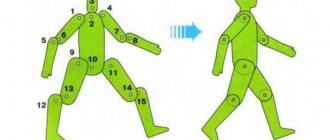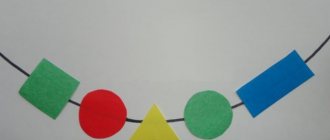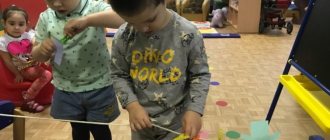Game 2. Good mood
This and the next game are best played on individual trays.
The presenter with the children remembers as many negative emotions as possible. Then each participant chooses “their” negative emotion and creates it in the sand. This could be a drawing in the sand, shapes or a name sculpted from sand (moistened with water or kinetic). After this, the leader helps the children remember positive emotions. It’s good if they turn out to be opposite, for example, “sadness” - “joy”, “hate” - “love”.
Then the participants begin to “conjure” and turn negative emotions into positive ones. If it's a drawing or writing in the sand, you can use cocktail straws to blow away the bad emotion (you need to blow very carefully so as not to get it in your eyes. The longer the straw, the better), and then draw a good emotion in its place.
If an emotion is a form sculpted from wet sand, then it is first broken, and then a new, positive emotion is molded in its place.
There is a more difficult version of the game. Children in a common sandbox create a whole world (country) of negative emotions. This may require natural materials, miniature figures of people, buildings, and animals. Then the participants in the game together destroy it and build a new world consisting of positive emotions and feelings.
MAGAZINE Preschooler.RF
SAND ART THERAPY IN KINDERGARTENSenchenko Valentina Viktorovna, teacher, MBDOU "Kindergarten No. 48" , Ryazan, Ryazan region, Russia
Perhaps, each of us has our own positive memories from childhood associated with playing in the sand - sea, river, or what is poured into sandboxes near the house. However, sand is not so simple. Seemingly simple games can be very beneficial for the mental health and development of children. Especially if these games are sand therapy.
Have you noticed that sand for babies has some magical powers? At a certain age, they begin to be attracted to it: children want to touch the sand, pick at it with a stick, play with toys, dig a hole.
First of all, sand therapy for children is an excellent opportunity for self-expression, the development of creative inclinations in a child, as well as a simple and effective way to learn to express their feelings, emotions, and experiences. Sand therapy classes under the guidance of a teacher or psychologist provide answers to many questions parents have regarding the inner emotional world of their child, allows you to uncover and see the true causes of conflicts, fears, and subsequently make corrections!
The creators of sand therapy are students of the famous psychologist and scientist Carl Jung. The therapy is based on the psychologist’s discovery of the fact that our unconscious communicates with us through symbols and hints, which often helps us recover from illnesses, cope with difficulties and resolve some difficult issues. Today, playing with sand is becoming increasingly popular. Sand therapy began to be actively used in kindergarten.
How it works? The paintings created on the sand by our hands are a reflection of the unconscious. They are like dreams, but you can also touch them. With their help, we bring out our experiences, internal problems, tormenting conflicts. A psychologist or teacher will help you look at all this in your picture, as well as realize what thoughts are disturbing you.
The sandbox is an excellent mediator for establishing contact with a child. And if he speaks poorly and cannot tell an adult about his experiences, then in such games with sand everything becomes possible. By playing out an exciting situation with the help of small figures, creating a picture of sand, the child opens up, and adults get the opportunity to see the child’s inner world at the moment, and during sand therapy it will definitely “flow out” onto the sandy surface. But this is far from the only advantage of sand therapy: it remarkably develops fine motor skills (sand, due to its structure, has a beneficial effect on tactile sensations and stimulates the nerve endings that are located in the fingertips), imagination, creativity, imaginative thinking and much more.
Working with sand is calming (especially for hyperactive children) - it seems to contain life-giving solar energy that recharges us with positive emotions.
Sand therapy is also good for preschoolers because when creating certain compositions, artistic skills are not needed, as in drawing. This means there is no room for disappointments, mistakes and self-doubt. During the “sand” lesson, children are relaxed, cheerful and inspired: they create their own world, and doing this is endlessly pleasant.
Sand therapy is akin to play, and in play a child learns about the world around him, overcomes difficulties, and learns to solve adult problems. The participation of a teacher or psychologist is important here, who will help the child find a solution and a way out of the current situation in a timely manner.
Sand therapy helps a lot in speech therapy. Children who have some kind of speech problems learn exercises reflected in the sand much faster. So, kids love to sculpt different letters, words, and letter combinations that are difficult for them. Children who have difficulty speaking overcome speech problems much faster, since sand affects the tactile-kinesthetic centers associated with those hemispheres of the brain that are responsible for the development of speech activity.
Older children can learn to write stories based on what they “drew” in the sand. This teaches them coherent speech, retelling skills, and this is really interesting to them: who doesn’t want to describe what kind of situation is depicted in the sand?
What do you need to play in the sand? But, in essence, so little is needed: Love, desire, kindness, So that Faith in Childhood does not disappear.
The simplest table drawer - Paint it with blue paint, A handful of golden sand will flow into it like a wondrous fairy tale.
A set of small toys Let's take it into the game... Like God We will create our own World of Wonders, Walking the Road of Knowledge.
To organize sand therapy you will need:
- Sand box (sandbox), size in centimeters: 50x70x8. It is believed that this size of the sandbox corresponds to the volume of the field of visual perception.
- Sand (regular, but sifted, clean)
- Water
- Collection of miniature figurines
The sandbox for sand therapy can be wooden or plastic. The main thing is that it has fairly high sides (so that the sand does not spill out) and a bottom painted blue. It will symbolize the sky or water, which makes it easier to play and create your own picture.
Classes are conducted using a large number of small figures and special sandboxes with dry or wet clean sand.
During classes, children love to travel to a fairyland with the Sandman, the keeper of the magical sandbox. Every time, sitting around the sandbox, the children listen to the Sandman's story about a new interesting game.
A classic sand therapy session begins with the psychologist giving the task to create a picture of his mood and the child choosing the most attractive toys for him.
It is important that they be varied and allow the child to involve different aspects of life in his games. These should be figures of people (preferably of different ages, different nationalities, professions, categories), both real and imaginary. Animal figures – domestic, wild, mythical. Some symbolic objects like mirrors, eggs, butterflies. Toy buildings and furniture: houses, churches, towers, castles. Connecting toys: ladders, ropes, stones, grains, beans. Cars, planes, trains, boats. Vegetation: trees, twigs, flowers, bushes. Various things: buttons, feathers, coins.
After which these same figures are placed in random order on one of the trays with sand. You can place them however you like: in one row, in a circle, at different ends of the tray, and so on. The figures can be connected by drawn “paths” (connections between objects), “traces” made by fingers, or they may not be connected by anything at all - everything is as the child wants to do it.
The therapeutic effect is achieved already at the stage of placing toys. When the picture is completed, the psychologist will be able to interpret what is bothering the child at a given period of time, and will also help him find a way out of a difficult situation during the game.
Calm music can be played in the practice room, or complete silence can reign, depending on the mood of the group and the age of the children.
In kindergarten and school settings, not only a psychologist can use a sandbox, but also teachers who can conduct educational games in the sand. Developmental exercises on the sand are more effective than standard teaching methods.
It is thanks to independent drawings in the sand that the child quickly masters letters and numbers, masters the concepts of “right” and “left ,” temporary concepts of day and night, and seasons. With the help of constructions in the sand, you can develop visual-figurative thinking, perception and memory. In the sandbox, tactile sensitivity and fine motor skills of the hand develop powerfully.
While playing on the sand, the child becomes interested, he tries to do it correctly, beautifully, accurately and, most importantly, quickly.
Children often cannot clearly articulate or name what is happening to them. By constructing various stories, a child can play out various difficulties in his life. For example, difficulties in communicating with children, indecisiveness or your own fears.
Playing with sand is a kind of self-therapy for a child with the help of a psychologist. The child is the master in the sandbox and, experiencing this feeling, he becomes internally stronger because he can change his pictures, stories, relationships and moods.
In games on the sand there are wars, a struggle between good and evil, but the child always knows that good will win! And this experience is very important for his future life.
In sand therapy, children gain inner freedom and confidence that no one will judge them and will accept them for who they are. First on the sand, and then in real life!
The goal of such therapy is not to change and remake the child, not to teach him any special behavioral skills, but to give him the opportunity to be himself.
What are the benefits of playing with sand?
- Develop perception, thinking, memory, attention, speech, self-control and self-regulation skills, creative thinking, imagination and fantasy;
- Form the child’s ideas about the world around him;
- Develop fine motor skills and eye
- Calms and relaxes, relieving tension;
- Develop a sense of success and self-confidence (that's how I do it!)
- They help you to understand your outer and inner world.
Along with the high effectiveness of the method, sand therapy also has contraindications. Not recommended in cases where:
- The level of anxiety of a child (adult) is very high;
- There are allergies and asthma to dust and small particles;
- There are skin diseases and cuts on the hands.
Forms and options of sand therapy
1. Game methods
Didactic gaming workshop using a sandbox is used for the little ones. Scientists have proven that sand absorbs negative energy, calms, and fills with harmony. This is why it is so useful for children to play in the sandbox.
A series of games based on the book by T.D. Zinkevich-Evstigneeva “Games in fairy tale therapy” , aimed at developing tactile-kinesthetic sensitivity and fine motor skills of the hands, creative imagination, help to understand the external and internal world)
1. "Sensitive palms"
Hot-cold, soft-hard, dry-wet.
2. “Our handprints” . Kids really like to make footprints and handprints in the sand, and use their fingers to depict animal tracks. It’s also very interesting and pleasant to bury your hands and feet in the sand.
3. Game “Secret” “What is hidden in the sand? Any toys are hidden in the sand, the hiding place is marked, the child’s task is to dig out the “secret” and then make a similar one.
4. Drawings in the sand. Using a stick you can draw letters, numbers, geometric shapes and entire pictures.
These simple exercises are of enormous importance for the development of a child’s psyche. Firstly, this kind of interaction with sand stabilizes the emotional state. Secondly, with the development of fine motor skills, we teach the child to listen to himself and pronounce his feelings, this contributes to the development of speech, voluntary attention, and memory. But most importantly, the child receives the first experience of reflection - he learns to understand himself and others.
2. For diagnostic purposes (individual and group form)
In an individual form, you can diagnose:
- The presence of internal conflicts (struggle, sand country in a state of destruction)
- Level and direction of aggression (hetero and auto-aggression)
- Conflicts with significant others. In this case, there is a confrontation between the heroes of the sand fairy tale, playing the role of real members of the author’s entourage
- Potential, resource opportunities (when there are some miraculous objects that bring deliverance and a happy resolution to the situation)
- Ways to overcome difficulties (mutual help, patronage, avoidance)
- Level of development of the emotional sphere (analysis of feelings, reflection)
- Analysis of the location of the figures in the sandbox and their meaning
In a group form of working with a sandbox, you can diagnose:
- The nature of interaction in the group
- Distribution of roles in the group
- Behavioral style of each group member
3. Method of psychocorrectional influence (for example, if a child has emotional and behavioral disorders of a neurotic nature). In other cases - as an auxiliary means to stimulate the child, develop his sensorimotor skills, reduce emotional stress, etc.)
Preschoolers with mental retardation, mental retardation, and children with disabilities are especially in need of such therapy. The leading characteristics of such preschoolers include weak emotional stability, impaired self-control in all types of activities, aggressive behavior and its provocative nature, difficulties in adapting to the children's group, fussiness, frequent mood swings, feelings of fear, mannerisms, familiarity towards adults. On the sand, each selected figurine represents a character who can interact with other characters. The child comes up with what they say or do; sometimes he may invite a psychologist to join the game and speak on behalf of a character. In all these cases, the child feels like the master of his small world and is the director of the drama that plays out on the sand sheet. What was previously hidden in the depths of a child’s soul comes to light; The characters of the game come into motion, expressing the most relevant feelings and thoughts for the child.
The proposed technique can be very useful for them. If a child has certain speech disorders, as in children with OSD, a series of “Sand Literacy” , aimed at developing phonemic awareness, correcting sound pronunciation, and teaching reading and writing.
The style and dynamics of play in the sandbox for children with intellectual development problems is up to 60 minutes. As a rule, the plot in their games is not clear and most often there is confrontation, struggle for territory, and parallel play.
It is important to note that in addition to moments of admiration, classes contribute to the development of manual motor skills and hand-eye coordination, which are necessary to prepare a child for writing. The fact is that in the human brain the centers responsible for speech and finger movements are located very close.
5. As a psychoprophylactic, developmental agent
Psychoprophylaxis is carried out with the aim of preventing problematic situations. Having the remarkable property of “grounding” negative mental energy, sand is an excellent psychoprophylactic agent. Psychoprophylactic and developmental aspects are manifested in the production of fairy tales and myths in the sandbox. By playing with your child, you can share your own life experiences with him.
6. In psychological counseling of children, adolescents and adults.
As a provision of primary psychological assistance.
DRAWING WITH SAND
This technique, called “Sand Art Therapy,” is amazing because it suggests using sand and the sand painting technique as a basis for creativity and self-knowledge.
To organize classes you will need:
- tablet/pallet/table - depending on the room (if the equipment is stationary, then you can have light tables, if you need to clean up after classes, then it is better to purchase tablets/pallets)
- quartz sand (you can have several options for colored sand for art therapy)
Sand drawing, sand animation - all these are names for the same activity, which has become extremely popular recently. And no wonder.
Sand painting is an unusual art of creating pictures using sand; it is an opportunity to express your feelings and emotions without words.
Sand painting develops:
- fine motor skills
- Improves memory
- Plastic movements
- Brain function
- Stress management
It is in this state that stress and internal tension are best relieved, problems go away...
It is especially characteristic of sand painting: by manipulating bulk materials, a person gets rid of negative emotions. Drawing occurs directly with your fingers in the sand, which promotes the development of sensory sensations, liberates and harmonizes, and also promotes the development of two hemispheres (since drawing occurs with both hands).
Even very young children can draw on the sand. This activity will develop motor skills no worse than finger painting, and it will create much less mess.
Experience with children has shown that the use of sand therapy gives positive results:
- Children feel more successful;
- Classes are fun, there is no boredom or monotony;
- In kindergarten, it is easier for children to adapt to a group environment;
- Fear and tension disappear.
Finding themselves in a fabulous sandy land, the children play in the Magic Sandbox and feel like real Wizards!
The article was prepared using freely accessible materials on the Internet.
Bibliography:
- T.D. Zinkevich-Evstigneeva T.M. Grabenko “Miracles on the sand” workshop on sand therapy. From "Rech" 2005
- T.D. Zinkevich-Evstigneeva T.M. Grabenko “Games in fairy tale therapy” St. Petersburg 2008
- M.V. Kisileva “Art therapy in working with children” St. Petersburg 2006
- T.D. Zinkevich-Evstigneeva Workshop on fairy tale therapy St. Petersburg 2013
- Dieckmann H. Methods in analytical psychology. - M.: LLC "TsGL "RON" , V. Sekachev, 2001. - 329 p.
- Sakovich N. A. Sand playing technology. Games on the bridge. - St. Petersburg: Rech, 2006. -176 p.
- Steinhardt L. Jungian sand therapy. -SPb.: Peter, 2001. -320 p.
| Next > |
Sand painting materials
To learn to draw on sand, you need to purchase a list of materials and equipment. All of them are affordable, you won’t have to fork out a lot of money. Here's what the young artist will need:
- table with sides and a lighting device at the bottom;
- sand;
- antistatic agent in a can;
- additional equipment - art brushes, sticks, sieve, templates;
- a wide and flat brush for sweeping grains of sand from the corners of the table.
An antistatic agent is necessary to prevent sand grains from sticking together, which is inevitable when quartz material is used repeatedly. The spray should be sprayed before each lesson. A regular antistatic agent is suitable, preventing synthetic clothing from sticking to the body.
You can buy a table or make it yourself. Homemade design - sides connected in a rectangular shape with a bottom made of frosted glass or plastic up to 5 mm thick. It is necessary to fix the lamp from below so that diffused light is obtained. The lighting can be anything: in the warm and cold range, even colored. The legs of the table should not wobble, otherwise when drawing you will not be able to draw neat lines.
The finished table is a structure with sides and a bottom in the form of an illuminated tablet. The optimal format is 130x70 cm, but for a child 70x50 cm is enough. The height of the sides should be at least 6-7 cm, but from the side of the drawer it is only 3 cm, otherwise it will be inconvenient to draw the lower elements. It is necessary to leave indentations for sand 10-15 cm wide on the right and left sides. It is advisable that these areas be in the same plane as the space for drawing, this makes it more convenient to use many techniques. But some ready-made tables have tray recesses on both sides.
Any sand will do. You can buy an aquarium one at a pet store, and a special one for creativity at a supermarket in the children's section. You can contact a children's and adult creativity studio where sand animation is practiced, if there is such an institution in the locality. They probably won't refuse to sell a small amount of sand. The fraction of the material can also be any. It is advisable to get different ones, since fine sand is convenient for creating tones and halftones, and coarse sand is convenient for creating large image details.
If there is a river near your house, you can dig up sand on the shore. You just have to filter it through a fine-mesh sieve, then rinse. The washing procedure looks like this:
- Pour 4-5 kg of sand into a bucket. This is the standard amount for drawing.
- Fill with water to the edge of the bucket.
- Stir gently with your hand or a large spoon.
- When dust and dirt particles rise to the surface and heavier grains of sand settle to the bottom, carefully drain the water.
- Repeat the procedure until the drained water becomes crystal clear.
- Dry the cleaned material on the balcony if the weather is sunny, or on a radiator, or in the oven.
You can replace sand with semolina, finely ground salt, and to create darker and more contrasting elements of the image - ground coffee.
Bulk material should be renewed once every 3 months, and if the child draws every day, then once every 1.5 months. If this is not done, the sand will become less pliable, since with constant friction the grains of sand are destroyed and the structure of the material softens.
Exercises
Here are some popular sand painting exercises on light tables for children:
- Letters. The lesson is useful for older preschoolers and younger schoolchildren who are learning to write. Spread sand on the table in a dense layer. Let your child learn to write letters beautifully and develop finger motor skills.
- Water landscape. To create it, walk with your outstretched fingers along the sandy surface, imitating waves. At the top of the composition, make thin strokes with your nail - these will be distant ripples. Draw the horizon with the edge of your palm, remove the excess in the upper part - this is the sky above the reservoir.
- Clouds. Take sand into your fist. Pour it out in a thin stream, making circular, non-sweeping movements.
- Maple Leaf. Draw lines that form the outline and veins of the leaf. Sharpen the outline by running your finger along the outer edge of the line, moving the sand inward. Use your fingernail to follow the veins. Outline the border of the petiole.
- Sun. Take sand into your fist and lift it 20-30 cm above the table surface. Pour out evenly, trying not to move your hand. Grains of sand, falling from a height, bounce off the plastic surface, form a ring, and the middle remains empty. And its diameter is wider, the higher the hand is raised.
- Mountain landscape. Spread the sand in a horizontal direction using quick zigzag movements. Use the edge of your little finger to walk along the upper part, removing the excess to create a relief.





